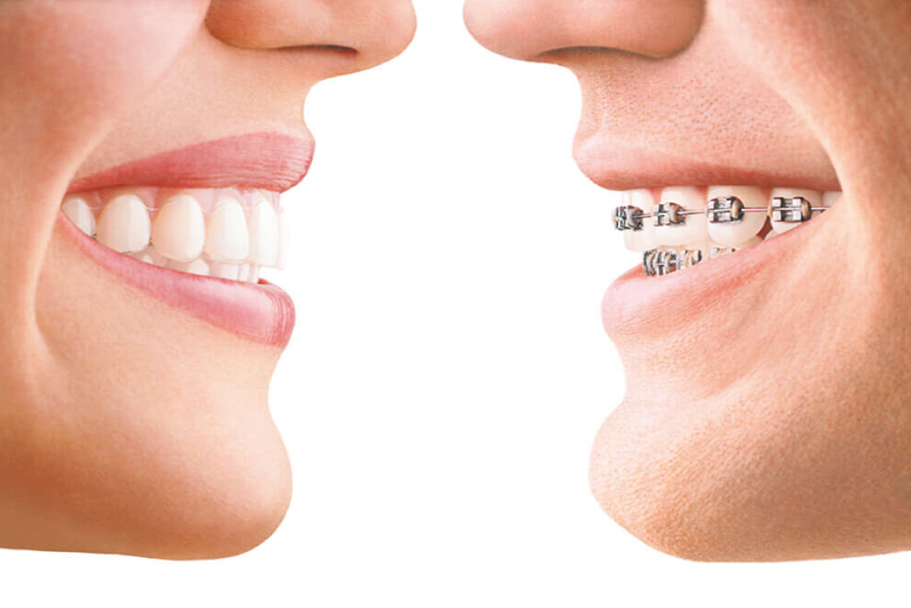BRACES AND ALIGNERS
Welcome to the world of orthodontic solutions, where braces and aligners have become synonymous with transforming smiles. These remarkable devices are designed to address misalignment issues and correct dental irregularities, helping individuals achieve not only a more aesthetically pleasing smile but also improved oral health. Braces, the traditional orthodontic option, utilize brackets and wires to gradually move teeth into their proper positions. On the other hand, aligners offer a discrete and removable alternative, making orthodontic treatment more convenient than ever before. At GIA clinics, we'll explore the benefits, differences, and considerations of braces and aligners, empowering you to make an informed choice on your journey to a straighter, healthier smile.

Dental Braces:
Dental braces consist of metal brackets, wires, and bands. The brackets are attached to each tooth, and wires are threaded through them. The tension applied to the wires helps move the teeth into their correct positions.
Treatment Steps:
- Consultation and Evaluation:The process begins with an initial consultation with an orthodontist. They will examine your teeth, take X-rays, and possibly create molds of your teeth to create a personalized treatment plan.
- Treatment Planning:Based on the evaluation, the orthodontist will create a customized treatment plan that outlines the specific adjustments needed to achieve the desired results.
- Braces Installation:During the next appointment, the braces will be installed. This involves attaching the brackets to each tooth using a special dental adhesive. Bands are placed around the molars to anchor the braces.
- Regular Adjustments:Approximately every 4-6 weeks, you'll have appointments for adjustments. During these visits, the orthodontist will tighten or replace wires and make any necessary changes to continue moving the teeth.
- Monitoring Progress:Throughout the treatment, the orthodontist will monitor the progress and make any necessary adjustments to the treatment plan.
- Maintaining Oral Hygiene:It's crucial to maintain thorough oral hygiene during treatment. Special brushes and tools may be recommended to clean around the braces effectively.
- Removal of Braces:Once the desired results are achieved, the braces will be removed. This process is typically painless and involves carefully detaching the brackets and wires.
- Retainers:After the braces are removed, a retainer may be provided to help maintain the new position of the teeth. Retainers are usually worn full-time initially and then transitioned to nighttime wear.
Dental Aligners:
Dental aligners are clear, removable trays made from a durable plastic material. They are custom-made to fit over the teeth snugly and gradually shift them into the desired position.
Treatment Steps:
- Consultation and Evaluation:Similar to braces, the process starts with a consultation where the orthodontist assesses your teeth and creates a treatment plan.
- 3D Scanning or Impressions:Detailed images or impressions of your teeth are taken, which are used to create a 3D model. This serves as the basis for designing your series of aligners.
- Aligner Fabrication:Based on the 3D model, a series of custom aligners is manufactured. Each aligner in the series represents a different stage of your teeth's movement.
- Wearing the Aligners:You will be provided with a set of aligners to wear for about 22 hours a day. They can be removed for eating, drinking, and cleaning.
- Changing Aligners:Approximately every 1-2 weeks, you will switch to the next set of aligners in the series. Each new set continues the progression of tooth movement.
- Regular Check-ups:You'll have periodic check-up appointments with your orthodontist to monitor progress and receive new sets of aligners.
- Oral Hygiene and Maintenance:Since aligners are removable, it's easier to maintain good oral hygiene. You'll need to clean both your teeth and the aligners regularly.
- Completion and Retainers:Once the treatment is complete and your teeth are in the desired position, your orthodontist may provide a retainer to prevent any relapse.
